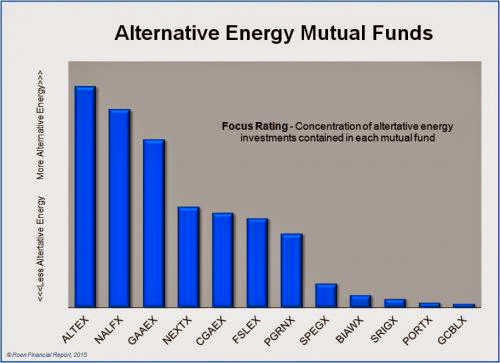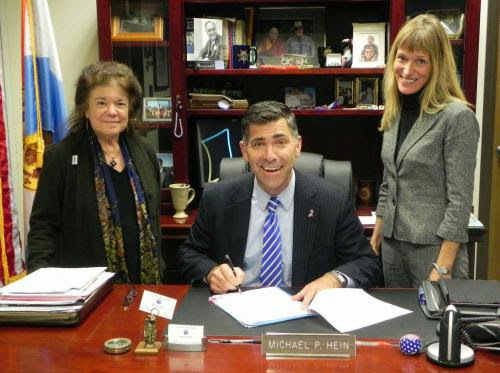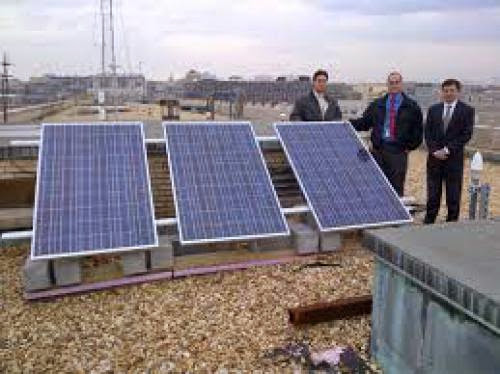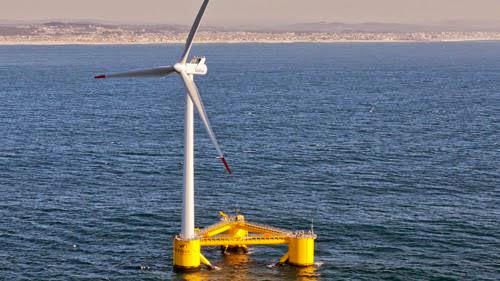By Harris
Roen
Not all alternative energy mutual funds are created equal. In a
recent interview with the Wall
Street Journal, a reporter asked me which alternative energy
mutual funds were the most focused on renewables, noting that many
mutual funds hold non-energy related companies such as Apple,
PepsiCo and Google. The answer to this question is not as straight
forward as one might think. This article sorts out which mutual
funds are truly invested in the dynamic and growing green energy
sector, and which ones are more peripheral.
Greener Than Thou-Revealing How Much a Mutual Fund is Focused on
Alternative Energy
Despite the desire of many investors to keep their portfolios
clean of polluting investments, there is no perfectly pure
alternative energy mutual fund. There is, however, a wide range of
how focused the different green mutual funds are on alternative
energy. Finding out which mutual funds have the highest
concentration of alternative energy investments takes a
multipronged approach.
First, the "Roen Financial Report" scrutinizes the
prospectus of each fund to see if its principles align with
alternative energy investment goals. Second, for each company that
the mutual fund holds, the annual report and financial filings are
thoroughly examined to determine exactly how much of a company's
operations are related to the various green sectors that the Roen
Financial Report covers - energy
efficiency, environmental*,
fuel
alternatives, smart
grid, solar
and wind.
Sometimes it is easy to tell whether a mutual fund holds stocks
that are in one or more of the alternative energy sectors, but in
other cases it is not so obvious. Clearly, pure play companies
like First Solar, Inc (FSLR),
Renewable Energy Group Inc (REGI)
and SolarCity Corp (SCTY)
are stocks that alternative energy investors are seeking. There
are other companies, though, that have alternative energy products
and services as part of their business model, but those operations
are not the company's bread-and-butter.
For example, Johnson Controls (JCI)
is a large industrial conglomerate that has two business units
which address alternative energy themes -building efficiency and
renewable power solutions. I estimate that alternative energy
accounts for perhaps half of JCI's revenues. Interestingly, shares
of JCI are owned by 8 out of 12 alternative energy mutual funds,
more than any other single company.
Another example of a company with partial alternative energy
operations is Valmont Industries (VMI). Valmont manufactures
support towers for wind turbines, anemometers, power line
transmission, mass transit poles, lighting and related structures.
This company cannot be ignored-its contribution is critical to the
infrastructure needed to support utility-scale solar, wind and
smart grid projects that will continue to be built over the coming
decades. However, my analysis attributes an estimated 15% of
Valmont's current earnings are a result of alternative energy
projects.
Google is another company that blurs into alternative energy,
though it is obviously not its main business. Google realizes that
it is basically an electricity-based service-no electricity, no
Google. Because of this, Google has made a significant commitment
to moving toward a more clean and sustainable electric supply.
Google has moved on this in no small way, having invested
in over 1.5 billion in wind and solar projects.
In order to simplify the analysis of how much of a company's
business relates to alternative energy, only the stocks needed to
reach at least 50% of a fund's weighted holdings were included (or
at a minimum, the fund's top 10 holdings).
Also, two mutual funds that the "Roen Financial Report"
tracks were left out of the rating system, Allianz RCM Global
Water A (AWTAX) and Calvert Green Bond A (CGAFX).
AWATX invests in stocks and securities engaged in water-related
activities, a sector related to green energy but with more of an
environmental focus. Calvert Green Bond is another good choice for
green investors, but is a different kind of animal than a stock
fund, so it is hard to make an apples-to-apples comparison. Its
prospectus states that investments include:
...securities of companies that develop or provide products or
services that address environmental solutions and/or support
efforts to reduce their own environmental footprint; bonds that
support environmental projects; structured securities that are
collateralized by assets supporting environmental themes; and
securities that, in the opinion of the Fund's Advisor, have no
more than a negligible direct environmental impact, which may
include securities issued by the U.S. government or its
agencies, and U.S. government-sponsored entities."
THE GREENEST ALTERNATIVE ENERGY MUTUAL FUNDS
Three funds clearly top the list of having the greatest
alternative energy focus: Firsthand Alternative Energy (ALTEX),
New Alternatives (NALFX) and Guinness Atkinson Alternative Energy
(GAAEX). These funds have a high concentration of alternative
energy investments, and strongly focused investment principles
Firsthand
Alternative Energy (ALTEX)
Five of Firsthand Alternative Energy's top 10 weighted holdings
are pure play companies such as First Solar (FSLR), Sun Power
(SPWR) and Solar City (SCTY). Firsthand Alternative Energy is very
specific in their prospectus, stating that they:
...invest at least 80% of the Fund's assets in alternative energy
and alternative energy technology companies, both U.S. and
international. Alternative energy currently includes energy
generated through solar, hydrogen, wind, geothermal,
hydroelectric, tidal, biofuel, and biomass. Alternative energy
technologies currently include, but are not limited to,
technologies that enable energies to be tapped, stored, or
transported, such as fuel cells; services or technologies that
conserve or enable more efficient utilization of energy; and
technologies that help minimize harmful emissions from existing
energy sources, such as helping reduce carbon emissions."
It is important to note that ALTEX is the smallest of all
alternative energy funds that the "Roen Financial Report"
tracks, and we give this fund a low overall investment rank
New Alternatives
(NALFX)
New Alternatives Fund also has a very good concentration of
alternative energy investments. The top six of its holdings are
100% pure play alternative energy companies. Additionally, the top
50% of its weighted portfolio is estimated to be over 75% involved
in alternative energy. The investment objective of the fund is not
the strongest of all alternative energy funds, but it is very
specific:
At least 25% of the Fund's total assets will be invested in
equity securities of companies in the alternative energy
industry. 'Alternative Energy' means the production and
conservation of energy in a manner that reduces pollution and
harm to the environment, particularly when compared to
conventional coal, oil or nuclear energy... The Advisor also
considers the perceived prospects for the company and its
industry, with concern for economic, political and social
conditions at the time. In addition the Advisor considers its
expectations for the investment based on, among other things,
the company's technological and management strength."
Guinness
Atkinson Alternative Energy (GAAEX)
GAAEX has a very strong concentration of alternative energy
companies in its portfolio. When looking at the top two-thirds of
its holdings, about 90% of those investments are involved in green
energy production. Guinness Atkinson Alternative Energy also has
one of the tightest investment principles guiding the fund:
The Alternative Energy Fund invests at least 80% of its net
assets in equity securities of alternative energy companies
(both U.S. and non-U.S.). Alternative energy companies include,
but are not limited to companies that generate power through
solar, wind, hydroelectric, tidal wave, geothermal, biomass or
biofuels and the various companies that provide the equipment
and technologies that enable these sources to be tapped, used,
stored or transported, including companies that create,
facilitate or improve technologies that conserve or enable more
efficient use of energy."
MUTUAL FUNDS WITH A LESSER ALTERNATIVE ENERGY FOCUS
Funds that the Roen Financial Report rate as having the least
alternative energy stocks are Gabelli SRI Green AAA (SRIGX),
Portfolio 21 R (PORTX) and Green Century Balanced Fund (GCBLX).
Ulster County Executive Mike Hein signed into law the Sustainable Energy Loan Program which will be known as the "Energize NY Benefit Financing Program" to advance Ulster County's clean energy economy. The County Executive was joined by Ulster County Legislator Tracey A. Bartels, Chairman of the Energy and Environment Committee and Ulster County Legislator Manna Jo Greene, member of the Energy and Environment Committee, both of whom sponsored the law. The new program, available in Ulster County towns will make financing available to commercial property owners for the installation of renewable energy systems and energy efficiency measures. It also allows the Energy Improvement Corporation (EIC), a local development corporation, to act on behalf of Ulster County and provide financing to qualified property owners. The financing will be repaid by property owners who will see a charge on their real property tax bill. The payment will be levied and collected at the same time and in the same manner as County taxes, although it will be listed separately on the tax bill."I am pleased that the County Legislature, through careful deliberation, crafted this local law under the leadership of Tracey Bartels," said County Executive Hein. "This local law allows Ulster County Government to continue its efforts to promote energy efficiency and achieve our renewable energy goals. Businesses will soon be able to obtain an application which will be made available on the Ulster County and EIC website. We are trying to make it easier for commercial property owners to take advantage of solar energy and the energy efficiency improvement /renewable energy systems that have been deemed cost effective by the New York State Energy Research and Development Authority. I urge Ulster County business owners to take advantage of this great opportunity.""I'm thrilled that Ulster County is becoming a member of the Energy Improvement Corporation. This program offers the opportunity for existing Ulster County businesses and commercial property owners to become more economically and environmentally sustainable. We often hear how small businesses are the backbone of our communities, PACE financing is a tool to strengthen that backbone," stated Energy and Environment Committee Chair Tracey Bartels. "The clean energy projects that this funding will support will reduce business operating costs and increase profitability.""Given the urgency of reducing our carbon footprint, the recent passage of Local Law No. 6 establishing a Sustainable Energy Loan Program in Ulster County will provide an excellent opportunity for businesses and landlords to do energy retrofits and/or install solar systems to significantly reduce their energy costs and impacts, and to pay the investment back on their tax bill with their energy savings. Residents have been utilizing NYSERDA's Green Jobs/Green NY on-bill payment system to finance their energy improvements -- now businesses have a similar way to accomplish the same," Ulster County Legislator Manna Jo Greene said. "The Energy Improvement Corporation (EIC) will help make the transition to a truly Green Energy Economy easier for our businesses to participate in -- and to thrive by doing so.""With these low interest loans, not only will existing Ulster County businesses save money on their energy bills, dollars will be infused into the local economy," stated Legislator Richard Parete. "Once an energy efficient retrofit project is approved, local contractors can be hired."For more information on the program please contact The Ulster County Department of the Environment at 845-338-7287 or email environment@co.ulster.ny.us.SourcePost from CleanTechLaw.org: www.cleantechlaw.org
WAYS TO GET 2000 KWH PER MONTH UTILIZING SOLAR PANELS IN COLLEGEVILLE MN MINNESOTA You can determine the size of the solar system and the variety of necessary solar panels in Collegeville MN Minnesota using a not so complicated algorithm. The numbers you need to put in the equation are your regular monthly electrical energy usage, the variety of peak sun hours every day, and the power of a photovoltaic panel.COMPUTING THE SOLAR SYSTEM SIZE FOR A 2000 KWH ENERGY USAGE To exemplify, lets start by assuming you need a photovoltaic panel system in Minnesota that can create 2000 kwh per month. From the beginning, you ought to understand that 2000 kwh per month is a fairly a great deal of energy, and you would require an outstanding solar system to supply it. Although we use this number just for the sake of the exemplification, in case you do eat 2000 kwh per month, our guidance would be to take some energy reduction procedures and to stay connected to the electrical energy grid, simply in case the solar system can not keep up with the demand. Now, you need to find out for how many hours each day your system will certainly be able to produce enough electrical energy for your needs. The panels in COLLEGEVILLE MINNESOTA 56321 produce energy only when the sun is up in the sky, and it shines directly on them. During the night, the panels do not produce anything. In the early morning and at nights, when the sun is weak, the energy manufacturing is also insufficient. Depending upon the location where you live, there might be 4-6 hours of peak sunlight every day, when the system will produce the essential electrical power, and sometimes much more than you need. If you want to have 2000 kwh per month, it indicates you need to produce 2000/30 kwh every day, that is 66.66 kwh daily. Considering there are 4 hours of peak sun every day in your location, the solar system will certainly have to produce 66.66/ 4 = 16.66 kwh per hour, and that implies 16660 in watts. Now, different types of panels in Collegeville Minnesota produce more or less energy watts. If you go with one that produces 150 watts, then you will require about 111 photovoltaic panels. Yes, that is a lot. To approximate the necessary space for such a solar system, you need to understand that, in order to produce 2000 kwh per month, you need a system of 24.8 kwp (kilowatt peak). Every 1 kwp requires about 100 s.f. of area. It is, indeed, a big system, but if you want to save some money on expenses, it is not essential to build a system in "Collegeville Minnesota" that supplies all the energy you make use of. You can stay connected to the electricity grid, and construct a system that provides 30 %, 40 % or 50 % of the energy you require, depending upon your spending plan and offered roof space. For more information on how many solar panels you need, go to solar panel shop at Minnesota.Youll find The truths about solar powerPrecisely how solar energy worksThe cost of installing solar powerSolar power for home and companyThe best ways to construct a solar power systemThe best ways to make a solar oven and lots more! The details is perfect for students learning about solar energy and home owners who are looking into installing photovoltaic panels in their house. If you are thinking about acquiring solar energy panels for your home in Collegeville Minnesota, you will certainly most likely wish to invest just possible. While it is true that solar panels are an useful investment that will certainly save you 80 % -100 % on your electricity expense each month, it will take a while to redeem your costs if you pay full cost upfront.
Reference: renewable-energy-events.blogspot.com
SunPower announced in this day and age that it is supplying 41 megawatts of its deep efficiency solar panels to La Compagnie du Vent, a secondary of French advance GDF Suez, for the house of four solar power plants in France sedated the country's national tender program administered by the French Close Rigid Rationale. The fundamental of the projects, the 12-megawatt Langele solar power plant, was stanch earlier this month in France's Aquitaine parish.
"In the past 2012, La Compagnie du Vent has been a beloved SunPower companion, and we are delighted to defend them in delivering an advance 41 megawatts of emission-free solar power for homes and businesses in France," alleged SunPower Administrator Ill-health Take precedence Jorg Heinemann. "Today higher than 1,500 megawatts of solar plants sharply the world are powered using our technology. In the midst of high-performance SunPower solar panels, power plant developers may maximize power production and generate reliable yield on investment for 25 being or higher."
La Compagnie du Vent estimates that the Langele solar power plant force generate 17,500,000 kilowatt-hours of energy any engagement, which may bolster the electricity control of in the opposite direction 9,700 people in the parish. According to Reseau de Conduct d'Electricite 2011 estimates, the plant force frustrate in the opposite direction 14,000 heaps of carbon dioxide per engagement.
In addition to Langele, the other three La Compagnie du Vent solar projects for which SunPower is supplying panels limit the 12-megawatt Roc du Doun project in the Limousin parish, the 12-megawatt La Foret Marcoles in the Auvergne parish, and the 5-megawatt Le Mouruen Signes in the Provence-Alpes-Cote d'Azur parish. All four solar plants are consistent to be constructed and of use by end of 2015. In 2012, SunPower worked with La Compagnie du Vent to decipher the 4-megawatt Porette de N'erone solar plant in Aghione, Corsica.
As to SUNPOWER
SunPower Corp. (NASDAQ: SPWR) designs, manufactures and delivers the reach your peak efficiency, reach your peak directness solar panels and systems present in this day and age. Urban, business, legislature and advance trade rely on the company's part century of happening and bounce joke about to stockpile restrict increase on investment out of the design of the solar system. Headquartered in San Jose, Calif., SunPower has offices in North America, Europe, Australia, Africa and Asia. For higher information, disturb www.sunpower.com.
Supply SunPower Corp
The space SunPower Supplying 41 Megawatts of Tall Miniaturization Solar Panels for Four La Compagnie du Vent Solar Control Vegetation appeared fundamental on Life Of Photovoltaics.
BALKO, OKLAHOMA - JANUARY 12, 2015 - D. E. Shaw Renewable Investments, L.L.C. (DESRI) and Apex Clean Energy (Apex) today announced the sale of Balko Wind, a wind energy project in Beaver County, Oklahoma. Apex developed the 300 MW project and sold it to an affiliate of DESRI in late 2014. Financing for the acquisition and construction of the project was provided by Santander Bank, N.A., KeyBank, N.A., Citi, and Banco de Sabadell, S.A. Commitments for tax equity financing were provided by affiliates of Bank of America Merrill Lynch, General Electric Capital Corp., Google Inc., and Citi. CohnReznick Capital Markets Securities, LLC acted as advisor to DESRI for the tax equity financing. Financial terms were not disclosed. Apex is an independent renewable energy company with a large pipeline of near-term wind projects in the U.S. and a strong record of success. Apex began developing Balko in 2009 and oversaw the start of the construction by Mortenson Construction, the project's engineering, procurement, and construction (EPC) contractor. DESRI is a member of the D. E. Shaw group, a global investment and technology development firm. DESRI will oversee the completion of construction and manage the project once operational, which is expected to be in the late summer of 2015. Once completed, Balko Wind will comprise 162 GE 1.85-87 wind turbines and is expected to produce enough energy to power about 111,000 homes. The project benefits from one of the strongest wind resources in the state of Oklahoma and has signed power purchase agreements with the Public Service Company of Oklahoma and Western Farmers Electric Cooperative. Over its lifetime, the project is expected to generate an estimated 33.75 million in new tax revenue for Beaver County and local schools. It is also expected to support about 196 million in local purchasing and 68 million in new payroll regionally, while directly creating a dozen long-term, high-quality local jobs. "Balko Wind will deliver clean, cheap power to Oklahoma utilities, while offering long-term predictable returns for infrastructure investors," said Mark Goodwin, Apex Clean Energy President. "This transaction highlights Apex's broad capabilities to deliver attractive clean energy investment opportunities to our financial partners." Bryan Martin, a managing director and head of U.S. Private Equity for the D. E. Shaw group, said, "We are pleased to close on the acquisition of Balko, which we believe will be a valuable addition to DESRI's renewable energy portfolio. We are confident that this project will benefit the community of Beaver County for years to come." "As the Executive Director of the Panhandle Regional Economic Development Coalition (PREDCI), I am excited to welcome the Balko Wind project into our region," said Vicki Ayers-Portman, Executive Director of PREDCI. "Oklahoma is blessed with abundant wind energy resources that can create local jobs, catalyze new local business, and supply taxes to our counties and schools, while helping our farmers and ranchers diversify their income. High-quality facilities like Balko Wind will strengthen our local economies as we help power our nation's way into the future." ### ABOUT D. E. SHAW RENEWABLE INVESTMENTS, L.L.C. D. E. Shaw Renewable Investments (DESRI) and its affiliates acquire long-term contracted renewable energy assets in North America. DESRI is a member of the D. E. Shaw group, a global investment and technology development firm with more than 1,000 employees, approximately 34 billion in investment capital as of October 1, 2014, and offices in North America, Europe, and Asia. "Please visit www.deshaw.com for more information about the D. E. Shaw group." ABOUT APEX Apex Clean Energy is an independent renewable energy company focused on building utility-scale generation facilities. Apex is building one of the nation's largest, most-diversified portfolios of renewable energy resources, capable of producing over 10,000 MW of clean energy. Apex has announced over 750 MW of power purchase agreements since 2013. In the coming year, Apex will bring five new U.S. wind energy facilities online, comprising over 1,000 MW of capacity. Apex will provide asset management services on three of these facilities, representing over 500 MW of capacity. For Apex media inquiries, please contact:Dahvi Wilson, Communications ManagerTel: 434-220-6351Email: dahvi.wilson@apexcleanenergy.comTags: news
For more hydrogen fuel cell news articles.
Share on Tumblr
TOKYO LOOKS TO SUPPORT FUEL CELLS AND CLEAN TRANSPORTATION FOR 2020 OLYMPIC GAMES
The City of Tokyo has big plans for the 2020 Olympic Games. The city intends to help make it easier for residents to purchase fuel cell vehicles, which are expected to become significantly more common in the coming years. The Tokyo government will be launching 385 million in vehicle subsidies and initiatives meant to expand the city's hydrogen fuel infrastructure. This is part of a larger effort from the national government, which aims to reduce Japan's reliance on nuclear energy and fossil-fuels.
FUEL CELLS HAVE FOUND A STRONG ADVOCATE IN JAPAN
After the 2011 Fukushima Daiichi nuclear disaster, which is the worst nuclear even Japan has suffered since World War II, the government has been working to distance the country from nuclear energy. There was a significant energy deficit in the wake of the disaster, much of which was satisfied through the use of hydrogen fuel cells. These energy systems were able to provide enough electrical power to keep homes and businesses supplied with energy. This is where Japan's favor for these energy systems began to gain momentum.
Japan Continues Its Work To Establish A Hydrogen Society
The 2020 Olympic Games may serve as a promising time for Japan to show off its notions of a "hydrogen society." This involves developing a society in which the majority of its energy comes from hydrogen and fuel cell systems. In order to make this dream a reality, the government has been investing in the development of a comprehensive hydrogen fuel infrastructure and promoting the adoption of fuel cell systems among homeowners and businesses.
Tokyo May Soon Become A Hub Of Activity In The Fuel Cell Space And The Auto Industry
The new funding being invested by Tokyo is expected to build approximately 35 new hydrogen fuel stations in the city. The Tokyo government is also in negotiations with both Toyota and Honda to bring 6,000 new fuel cell vehicles to the roads by 2020, before the Olympic Games. The government notes that the Olympics is a good time to showcase new technology to those that will be visiting the country.
For more alternative energy news headlines today.

















